change time CADILLAC DEVILLE 1993 7.G User Guide
[x] Cancel search | Manufacturer: CADILLAC, Model Year: 1993, Model line: DEVILLE, Model: CADILLAC DEVILLE 1993 7.GPages: 406, PDF Size: 20.78 MB
Page 204 of 406
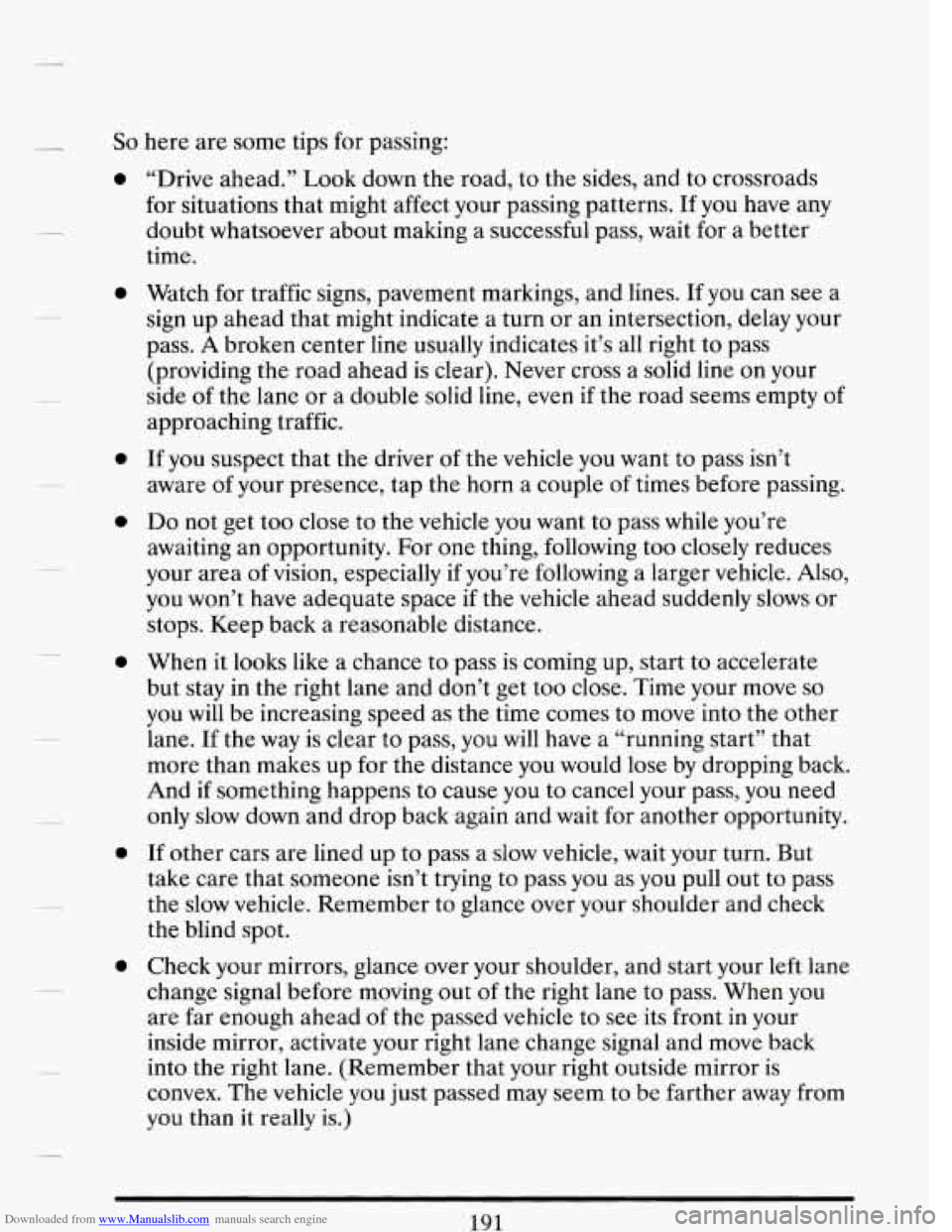
Downloaded from www.Manualslib.com manuals search engine So here are some tips for passing:
0
0
0
0
0
0
0
“Drive ahead.” Look down the road, to the sides, and to crossroads
for situations that might affect your passing patterns.
If you have any
doubt whatsoever about making a successful pass, wait for a better
time.
Watch for traffic signs, pavement markings, and lines.
If you can see a
sign up ahead that might indicate a turn or an intersection, delay your
pass. A broken center line usually indicates it’s all right to pass
(providing the road ahead is clear). Never cross a solid line on your
side
of the lane or a double solid line, even if the road seems empty of
approaching traffic.
If you suspect that the driver of the vehicle you want to pass isn’t
aware
of your presence, tap the horn a couple of times before passing.
Do not get too close to the vehicle you want to pass while you’re
awaiting an opportunity.
For one thing, following too closely reduces
your area
of vision, especially if you’re following a larger vehicle. Also,
you won’t have adequate space if the vehicle ahead suddenly slows or
stops. Keep back a reasonable distance.
When it looks like a chance to pass is coming up, start to accelerate
but stay in the right lane and don’t get too close. Time your move
so
you will be increasing speed as the time comes to move into the other
lane.
If the way is clear to pass, you will have a “running start” that
more than makes up for the distance you would lose by dropping back.
And
if something happens to cause you to cancel your pass, you need
only
slow down and drop back again and wait for another opportunity.
If other cars are lined up to pass a slow vehicle, wait your turn. But
take care that someone isn’t trying to pass you as you pull out to pass
the slow vehicle. Remember to glance over your shoulder and check
the blind spot.
Check your mirrors, glance over your shoulder, and start your left lane
change signal before moving out
of the right lane to pass. When you
are far enough ahead
of the passed vehicle to see its front in your
inside mirror, activate
your right lane change signal and move back
into the right lane. (Remember that your right outside mirror
is
convex. The vehicle you just passed may seem to be farther away from
you than it really is.)
191
Page 206 of 406
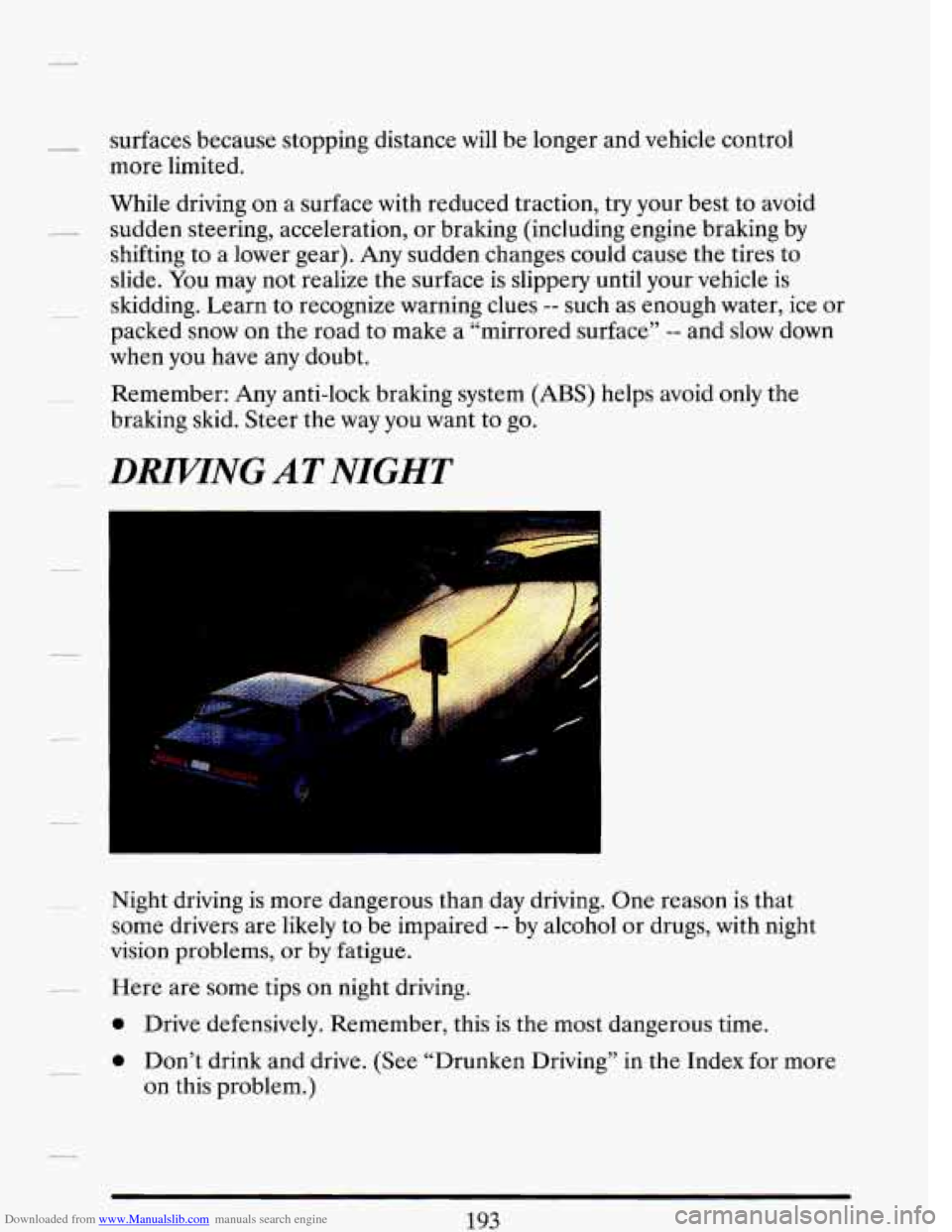
Downloaded from www.Manualslib.com manuals search engine surfaces because stopping distance will be longer and vehicle control
more limited.
While driving on a surface with reduced traction, try your best to avoid
sudden steering, acceleration, or braking (including engine braking by
shifting to
a lower gear). Any sudden changes could cause the tires to
slide. You may not realize the surface is slippery until your vehicle is
skidding. Learn to recognize warning clues
-- such as enough water, ice or
packed snow on the road to make a “mirrored surface”
-- and slow down
when you have any doubt.
Remember: Any anti-lock braking system
(ABS) helps avoid only the
braking skid. Steer the way you want to go.
DRIPTNG AT NIGHT
Night driving is more dangerous than day driving. One reason is that
some drivers are likely to be impaired
-- by alcohol or drugs, with night
vision problems, or
by fatigue.
Here are some tips on night driving.
0 Drive defensively. Remember, this is the most dangerous time.
0 Don’t drink and drive. (See “Drunken Driving” in the Index for more
on this problem.)
193
Page 218 of 406

Downloaded from www.Manualslib.com manuals search engine 0 Lights: Are they all working? Are the lenses clean?
0 Tires: They are vitally important to a safe, trouble-free trip. Is the
tread good enough for long-distance driving? Are the tires all inflated
to the recommended pressure?
0 Weather Forecasts: What’s the weather outlook along your route?
Should you delay your trip a short time
to avoid a major storm
system?
Maps: Do you have up-to-date maps?
ON THE ROAD
Unless you are the only driver, it is good to share the driving task with
others. Limit turns behind the wheel to about
100 miles (160 km) or two
hours at a sitting. Then, either change drivers or stop for some
refreshment like coffee, tea or soft drinks and some limbering up. But do
stop and move around. Eat lightly along the
way. Heavier meals tend to
make some people sleepy.
On two-lane highways or undivided multilane highways that
do not have
___ controlled access, you’ll want to watch for some situations not usually
found on freeways. Examples are: stop signs and signals, shopping centers
with direct access to the highway, no passing zones and school zones,
vehicles turning left and right off the road, pedestrians, cyclists, parked
vehicles, and even animals.
HIGHFKAY HIPNOSIS
Is there actually such a condition as “highway hypnosis”? Or is it just
plain falling asleep at the wheel? Call it highway hypnosis, lack of
__ awareness, or whatever.
There is something about an easy stretch
of road with the same scenery,
along with the hum
of the tires on the road, the drone of the engine, and
the rush
of the wind against the vehicle that can make you sleepy. Don’t
let it happen to you! If it does, your vehicle can leave the road in less than
a second, and you could crash and be injured.
What can you do about highway hypnosis? First, be aware that it can
happen.
205
Page 230 of 406
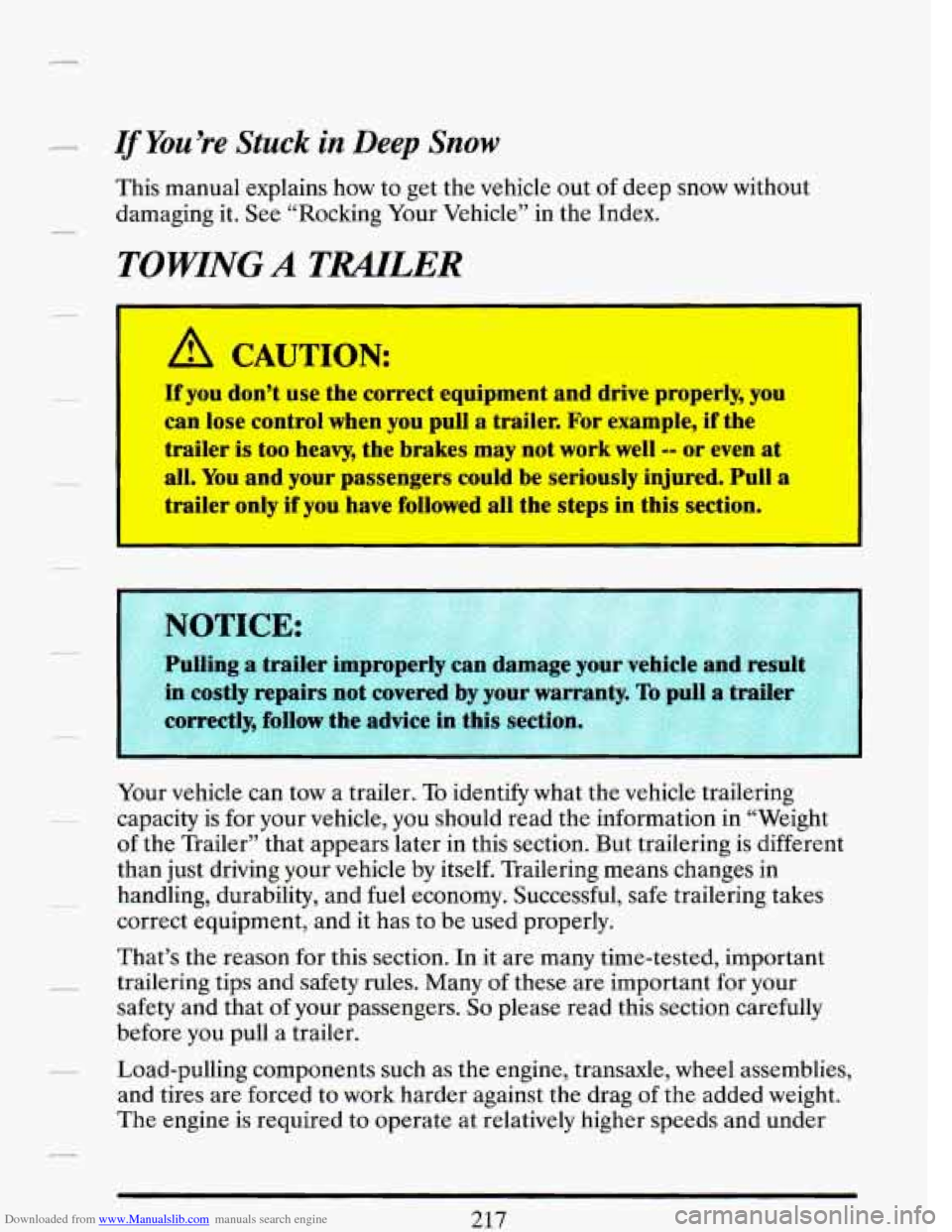
Downloaded from www.Manualslib.com manuals search engine If You’re Stuck in Deep Snow
This manual explains how to get the vehicle out of deep snow without
damaging it. See “Rocking Your Vehicle” in the Index.
TOWING A TWLER
I
‘ A CAUTION:
If you don’t use the correct equipment and drive properly, you
can lose control when you pull
a trailer. For example, if the
trailer
is too heavy, the brakes may not work well -- or even at
all. You and your passengers could be seriously injured. Pull a
trailer only if you have followed all the steps in this section.
Your vehicle can tow a trailer.
To identify what the vehicle trailering
capacity is for your vehicle, you should read the information in “Weight
of the Trailer” that appears later in this section. But trailering is different
than just driving your vehicle by itself. Trailering means changes in
handling, durability, and fuel economy. Successful, safe trailering takes
correct equipment, and it has to be used properly.
That’s the reason for this section. In
it are many time-tested, important
trailering tips and safety rules. Many of these are important for your
safety and that
of your passengers. So please read this section carefully
before you pull a trailer.
Load-pulling components such as the engine, transaxle, wheel assemblies,
and tires are forced to work harder against the drag of the added weight.
The engine is required
to operate at relatively higher speeds and under
217
Page 234 of 406

Downloaded from www.Manualslib.com manuals search engine electric brakes, start your vehicle and trailer moving and then apply the
trailer brake controller by hand to be sure the brakes are working. This
lets you check your electrical connection at the same time.
During your trip, check occasionally to be sure that the load is secure,
and that the lights and any trailer brakes are still working.
Following Distance
Stay at least twice as far behind the vehicle ahead as you would when
driving your vehicle without
a trailer. This can help you avoid situations
that require heavy braking and sudden turns.
Passing
You’ll need more passing distance up ahead when you’re towing a trailer.
And, because you’re a good deal longer, you’ll need to go much farther
beyond the passed vehicle before you can return to your lane.
Backing Up
Hold the bottom of the steering wheel with one hand. Then, to move the
trailer to the left, just move that hand to the left.
To move the trailer to
th.e right, move your hand to the right. Always back up slowly and,
if
possible, have someone guide you.
Making Turns
When you’re turning with a trailer, make wider turns than normal. Do
this so your trailer won’t strike soft shoulders, curbs, road signs, trees, or
other objects. Avoid jerky
or sudden maneuvers. Signal well in advance.
Turn Signals When Towing a Trailer
When you tow a trailer, your vehicle has to have a different turn signal
flasher and extra wiring. The green arrows on your instrument panel
will
flash whenever you signal a turn or lane change. Properly hooked up, the
trailer lights will also flash, telling other drivers you’re about to turn,
change lanes or stop.
When towing
a trailer, the green arrows on your instrument panel will
flash for turns even
if the bulbs on the trailer are burned out. Thus, you
221
Page 266 of 406
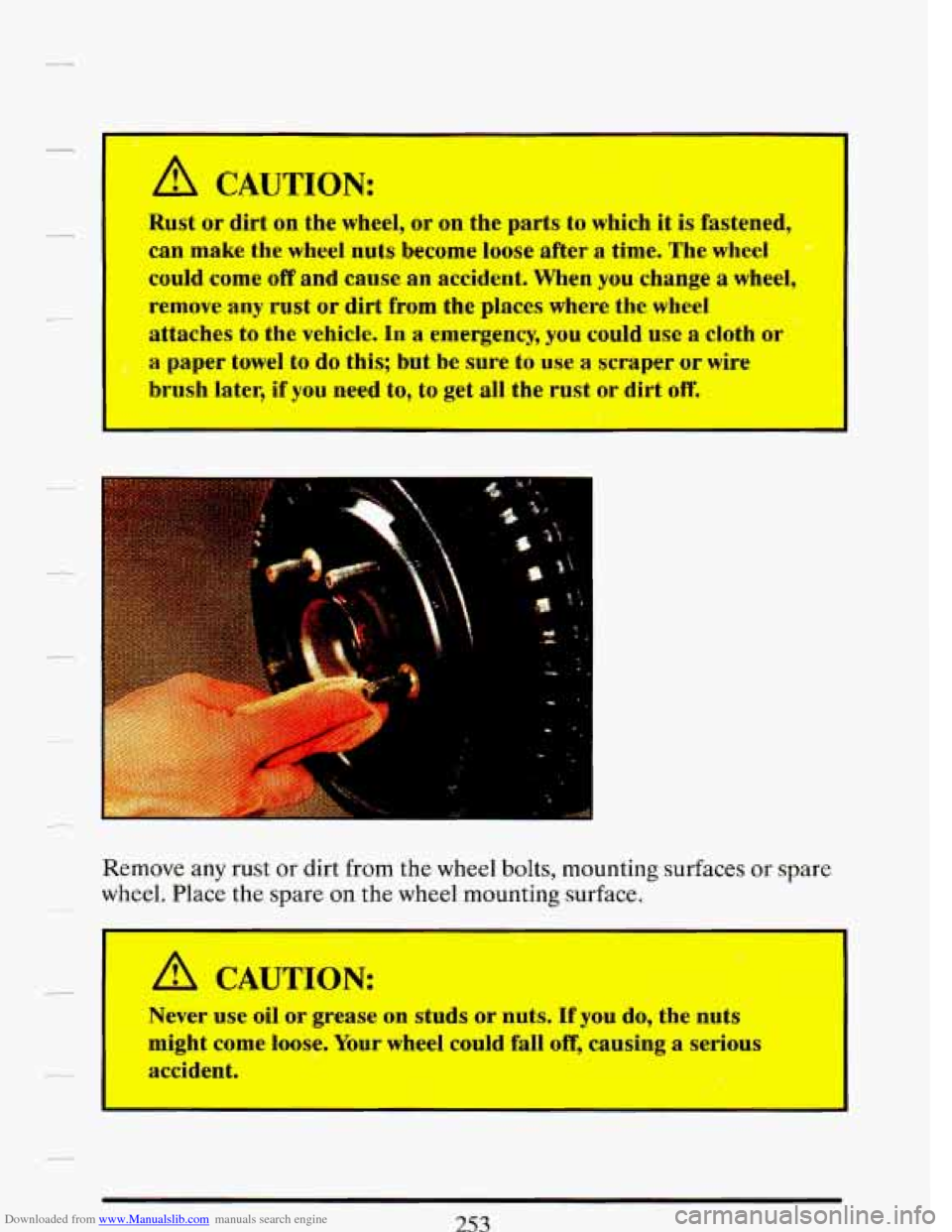
Downloaded from www.Manualslib.com manuals search engine c
A CAUTION:
Rust or dirt on the wheel, or on the parts to which it is fastened,
can make the wheel nuts become loose after a time. The wheel
could come off' and cause an accident. When you change a wheel,
remove
any rust or dirt from the places where the wheel
attaches
to the vehicte. In a emergency, you could use a cloth or
a paper towel to do this; but be sure to use a scraper or wipe
brush later, if you need to, to get all the rust'or dirt off.
-I
Remove any rust or dirt from the wheel bolts, mounting surfaces or spare
wheel. Place the spare on the wheel mounting surface.
I .Never use oil or grease on studs or nuts. If you do, the nuts
might
come loose. Your wheel could fall off, causing a serious
accident.
253
Page 285 of 406
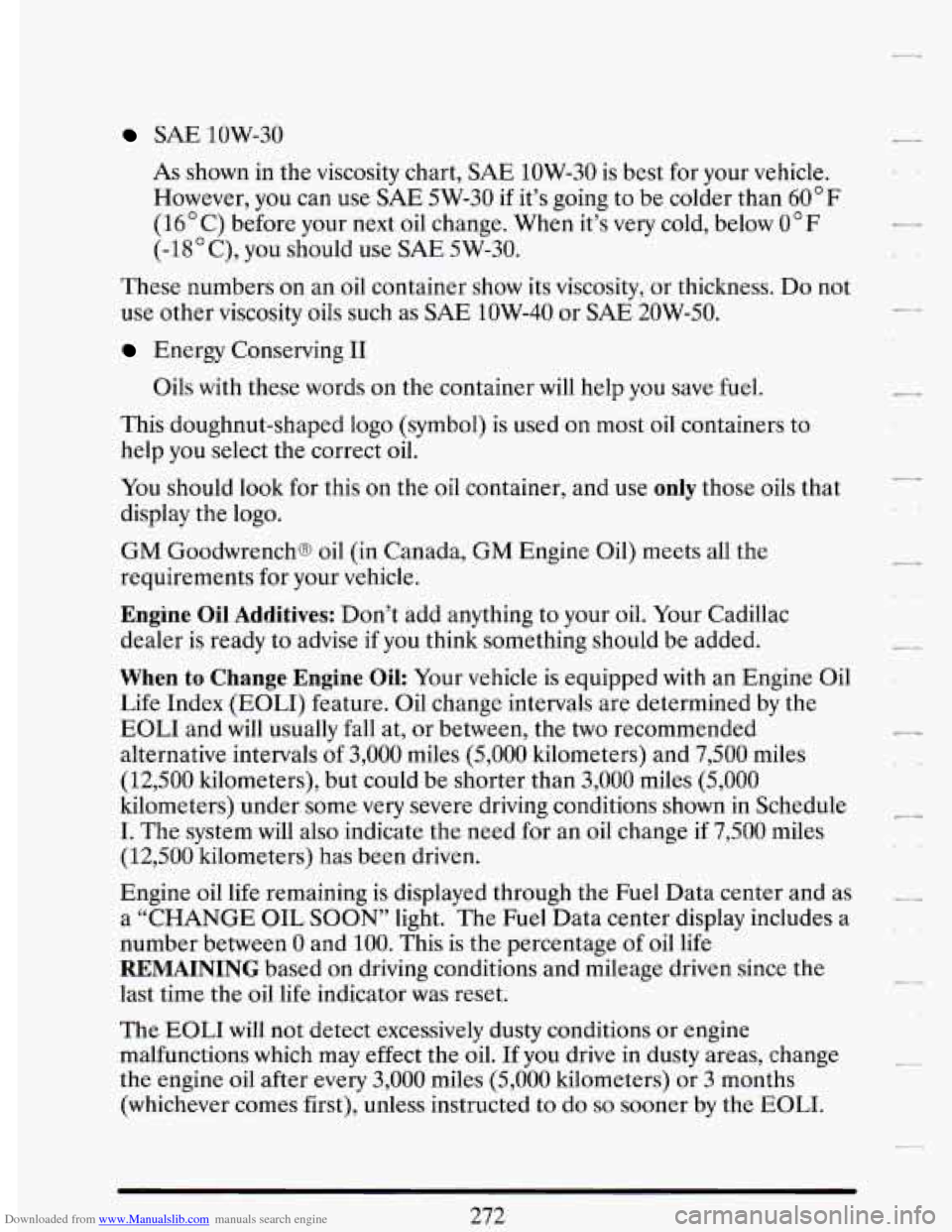
Downloaded from www.Manualslib.com manuals search engine SAE 1OW-30
As shown in the viscosity chart, SAE 1OW-30 is best for your vehicle.
However, you can use
SAE 5W-30 if it’s going to be colder than 60°F
(16°C) before your next oil change. When it’s very cold, below
O°F
(-18”C), you should use SAE 5W-30.
These numbers
on an oil container show its viscosity, or thickness. Do not
use other viscosity oils such as SAE 1OW-40 or SAE
20W-50.
Energy Conserving I1
Oils with these words on the container will help you save fuel.
This doughnut-shaped logo (symbol) is used on most
oil containers to
help you select the correct
oil.
You should look for this on the oil container, and use only those oils that
display the logo.
GM Goodwrench@
oil (in Canada, GM Engine Oil) meets all the
requirements for your vehicle.
Engine Oil Additives: Don’t add anything to your oil. Your Cadillac
dealer is ready to advise if you think something should be added.
When to Change Engine Oil: Your vehicle is equipped with an Engine Oil
Life Index (EOLI) feature. Oil change intervals are determined by the
EOLI and will usually fall at, or between, the two recommended
alternative intervals of 3,000 miles
(5,000 kilometers) and 7,500 miles
(12,500 kilometers), but could be shorter than 3,000 miles (5,000
kilometers) under some very severe driving conditions shown in Schedule
I. The system will also indicate the need for an oil change if 7,500 miles
(12,500 kilometers) has been driven.
Engine oil life remaining is displayed through the Fuel Data center and as
a
“CHANGE OIL SOON” light. The Fuel Data center display includes a
number between
0 and 100. This is the percentage of oil life
REMAINING based on driving conditions and mileage driven since the
last time the oil life indicator was reset.
The EOLI will not detect excessively dusty conditions or engine
malfunctions which may effect the
oil. If you drive in dusty areas, change
the engine
oil after every 3,000 miles (5,000 kilometers) or 3 months
(whichever comes first), unless instructed to
do so sooner by the EOLI.
c-
LC
c-
.- -
c-
.L
.,
272
Page 286 of 406

Downloaded from www.Manualslib.com manuals search engine How To Reset the Oil Life Indicator: After the oil has been changed,
press and hold the
“RANGE” and “RESET” buttons between 5 and 60
seconds. Once the buttons are released the “CHANGE OIL SOON”
light will flash 4 times to indicate it has reset to 100. If the “CHANGE
OIL SOON” light comes on for 5 seconds it did not reset. You will need
to reset the system again. The percentage
of oil life remaining may be
checked at any time by pressing the
“RANGE” and “FUEL USED” on
the Fuel Data center.
Engine Block Heater: An engine block heater can be a big help if you
have to park outside
in very cold weather, O°F (-18OC) or colder. If your
vehicle has this option, see “Engine Block Heater” in the Index.
What to Do with Used Oil:
’
A CAUTION:
Used engine oil contains things that have caused skin cancer in
laboratory animals. Don’t let used oil stay
on your skin for very
long. Clean your skin and nails with soap and water, or a good
hand cleaner. Wash or properly throw away clothing or rags
containing used engine oil.
Used oil can be a real threat to the environment. If you change your own
oil, be sure to drain all free-flowing oil from the filter before disposal.
Don’t ever dispose
of oil by pouring it on the ground, into sewers, or into
streams or bodies
of water. Instead, recycle it by taking it to a place that
collects used oil.
If you have a problem properly disposing of your used
oil, ask your dealer, a service station or
a local recycling center for help.
Page 288 of 406
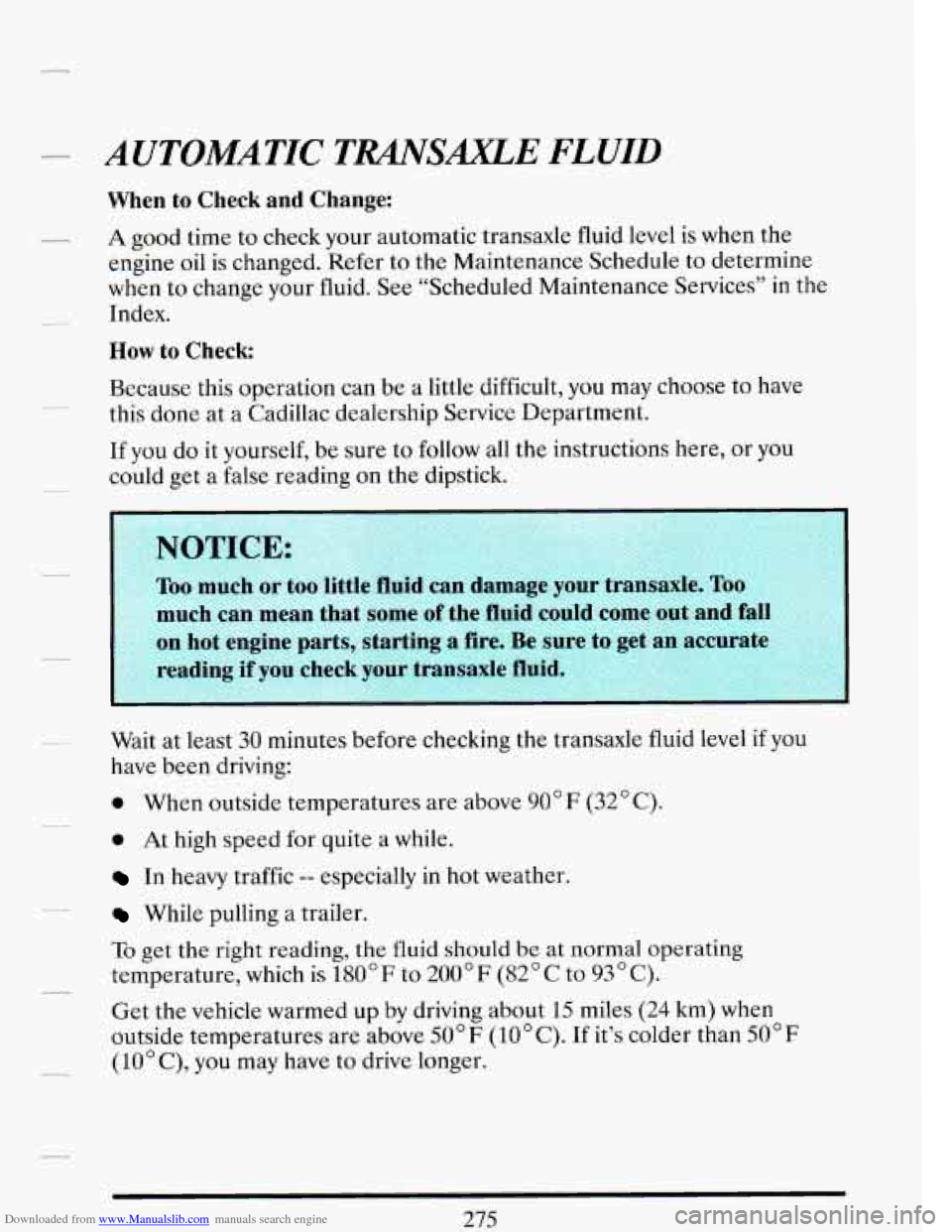
Downloaded from www.Manualslib.com manuals search engine AUTOMATIC TRAS.E FLUID
When to Check and Change:
A good time to check your automatic transaxle fluid level is when the
engine oil is changed. Refer to the Maintenance Schedule to determine
when to change your fluid. See "Scheduled Maintenance Services"
in the
Index.
How to Check
Because this operation can be a little difficult, you may choose to have
this done
at a Cadillac dealership Service Department.
If you do it yourself, be sure to follow all the instructions here, or you
could get a false reading on the dipstick.
Wait at least
30 minutes before checking the transaxle fluid level if you
have been driving:
0 When outside temperatures are above 90" F (32°C).
0 At high speed for quite a while.
In heavy traffic -- especially in hot weather.
While pulling a trailer.
To get the right reading, the fluid should be at normal operating
temperature, which is
180°F to 200" F (82 " C to 93 " C).
Get the vehicle warmed up by driving about 15 miles (24 km) when
outside temperatures are above
50°F (10°C). If it's colder than 50°F
(10" C), you may have to drive longer.
275
Page 322 of 406

Downloaded from www.Manualslib.com manuals search engine ’ A CAUTION
Rust or dirt on a wheeI, or on the parts to which it is hstened,
cam make wheel nuts become loose after a time. Tbe wheel could
come off and cause an accident. When y~n change a wheel,
remove any rust or dirt fkom places where the wheel attaches to
the vehicle. In an emergency, you can use a cloth or a paper
towel to do this; but be sure to use a scraper of wire brush later,
if you need to, to get all the rust or dirt off. (See %hanging a
Flat Tire” in the T- ---*
I
When It’s Time for New Tires
One way to tell when
it’s time for
new tires is
to check the treadwear
indicators, which will
appear when your tires
have only 2/32 inch
(1.6 mm) or less of
tread remaining.
You need a new tire if:
ire.
0 You can see the indicators at three places around the t
You can see cord or fabric showing through the tire’s rubber.
The tread or sidewall is cracked, cut or snagged deep enough to show
cord or fabric.
The tire has a bump, bulge or split.
309